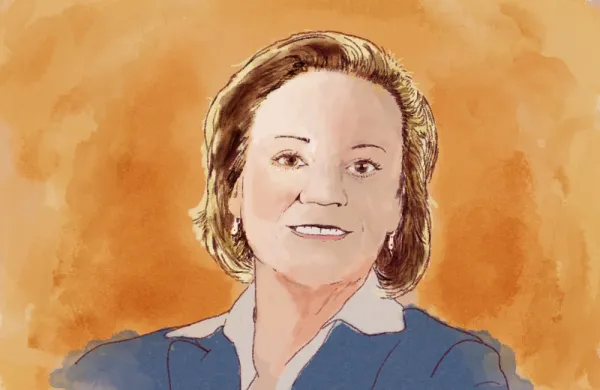The retreat of public funding has left critical gaps in the innovation chain. In women’s health, that means promising solutions stall, not for lack of science, but because the risk is now mispriced.
A System Built on Shared Burden
In theory, innovation funding is a relay. Public dollars de-risk early science. Philanthropy or angel capital picks up traction. Venture capital drives scale. Institutional money sustains. It was never perfectly sequenced, but there was alignment.
Now, the baton has been dropped. In women’s health, the gap isn’t just financial. It’s cultural.
When public funding disappears, it doesn’t just remove capital. It removes permission and validation. The institutional signals that capital relies on.
And capital follows signals.
The Evidence of Retreat
In 2025, the U.S. National Institutes of Health (NIH) faced real-dollar budget cuts for the first time in over a decade 1. The contraction hit hardest in areas that were already underfunded; OB/GYN research, menopause, chronic pain, autoimmune conditions 2. OB/GYN-specific research, for example, has long received less than 3% of the NIH budget, despite the scale of patient need.3
The story is similar in Europe. Horizon Europe has invested over €2 billion in women’s health through major programs but most of that has gone to oncology, reproductive health, and personalized medicine 4. Conditions like endometriosis, menopause, and maternal care remain underprioritized. Institutions like the University of Bergen have called for course correction 5.
In the UK, national plans to expand menopause and maternal care haven’t translated into access. Hormone replacement therapy (HRT), for instance, still follows a postcode lottery with wide disparities across regions 6.
In the U.S., most states expanded Medicaid postpartum coverage to 12 months by the end of 2024. But four states still haven’t adopted the policy 7. It’s a small number but one that hits low-income women hardest. And it signals how incomplete commitments can quietly erode early-stage innovation.
These aren’t just delays. They are cracks in the signalling system. And when public signals disappear, validation breaks down, long before capital even enters the room.
Who Bears the Cost Now?
As public backing recedes, the private market is absorbing risk it was never meant to carry. Founders must now do what used to be shared across national labs, academic consortia, and public health systems: validate science and prove traction, all before reimbursement codes exist.
Consider Mahmee, a maternal care coordination platform founded by Melissa Hanna. After identifying critical gaps in postpartum infrastructure, the company raised venture capital supported by investors like Goldman Sachs, Serena Williams, and Mark Cuban to build services that public systems had failed to deliver.8
Or take Evvy, a vaginal microbiome diagnostic company. Its founders launched the platform to address a major blind spot in women’s health research, an area historically overlooked by traditional research funders. Backed early by private investors, Evvy began building a clinical evidence base in a field that public research systems had historically underfunded.9 10
Diagnostics companies developing tools for chronic pelvic pain or endometriosis face a difficult choice: self-fund underpowered trials or delay validation. A 2023 Rock Health report noted that many FemTech founders face serious capital gaps at the clinical validation stage, particularly for diagnostic tools with long reimbursement timelines.11 Some companies turn to direct-to-consumer strategies not because it’s their optimal model, but because there is no reimbursable path forward without years of unfunded data collection.
These aren’t isolated stories but reflect a broader shift: the privatization of validation.
Without grants, pilot programs, or early public partnerships, the burden of proof shifts entirely to the private domain. But that domain wasn’t built to absorb this kind of risk.
Why the Chain Breaks
Private capital is signal-driven. For decades, those signals came from the public sector. Grant awards, pilot studies, academic partnerships, early adoption by public health systems.
When those disappear, private capital doesn’t rush in. It waits.
The result? Capital stalls at Series A. Funders hesitate, not because the company is weak, but because the external signals they rely on to validate the opportunity never arrive. This is especially true for institutional allocators evaluating new sectors. Without NIH grants, NHS pilots, or Medicaid reimbursements, women’s health companies appear early, ambiguous, and high risk even when their science is strong.
The structural issue isn’t just undercapitalization. It’s signal erosion.
A Structural Mismatch
Private capital was designed to scale solutions. Not subsidize them.
Institutional mandates are built on principles of scalability, de-risked science, and repeatable exits. But in women’s health, the standard cues are missing, and so is the capital.
- CPT codes lag behind innovation.
- Reimbursement timelines stretch beyond venture horizons.
- Regulatory frameworks are outdated or unclear.
- Public-private partnerships are slow, bureaucratic, or non-existent.
None of this is reflected in the pitch deck. But it all shows up in the risk models. Without the signals public capital once provided, allocators may hesitate, wait or they might pass.
What Allocators Can Do Differently
As public signals recede, some allocators are exploring new ways to evaluate early-stage health innovations particularly in areas like women's health, where traditional benchmarks may lag.
Rather than interpreting the absence of public funding as a red flag, a growing number view it as a potential marker of structural mispricing. In this context, they look for alternative indicators of validation, including:
- Unmet patient demand
- Clinician-led adoption
- Willingness to pay out-of-pocket
- Real-world evidence from early users
- Cash-pay traction in adjacent or underserved markets
Some funds have also begun to target moments of inflection, where strong science meets reimbursement uncertainty, as windows for catalytic capital. In these cases, early conviction from angels or family offices is not dismissed as noise but assessed as an additional signal of feasibility or latent demand.
This is not about taking outsized risk. It's about recognizing that the retreat of public capital sometimes requires a recalibration of traditional frameworks.
Capital Doesn’t Just Fund. It Endorses.
When public funding disappears, it doesn’t just shrink the pie. It narrows the path and redefines which innovations are seen as “real.”
The risk now is not just financial. It’s systemic: we are asking private capital to carry breakthroughs across a chasm it was never designed to span alone.
And unless someone rewrites the playbook, even the most promising ideas will continue to stall at the edge of relevance, not because they failed, but because the market was missing a mandate.
This is the second in a three-part series on the capital chain in women’s health. In the final piece, we will explore why early conviction isn’t just admirable but catalytic. We will examine how co-investment structures, mandate design, and early LP alignment can rebuild momentum, and why allocators who move early aren’t taking more risk but defining the market.
Maryann Umoren Selfe is a strategist and investor focused on capital design for the future of health. Through FemmeHealth Ventures Alliance, she explores how overlooked sectors like women’s health become investable.
The views expressed are solely those of the author in their personal capacity and do not constitute investment advice or an offer to buy or sell any financial instrument.
The views expressed by the author do not necessarily reflect the views of Institutional Investor.
Market Intelligence Is Independent of the Institutional Investor Magazine Newsroom.
1 Joseph, A. (2025, June 27). Despite resumption of NIH grant reviews, research funding gap grew. STAT. https://www.statnews.com/2025/06/27/despite-resumption-of-nih-grant-reviews-research-funding-gap-grew/
2 Rosser, T. (2020). Increasing NIH funding for academic departments of obstetrics and gynecology. Implementation Science, 15, 76. https://doi.org/10.1016/S0002‑9378(20)30373‑2
3 D’Alton, M. E., Reddy, U. M., Rich-Edwards, J. W., & Pinn, V. W. (2022). Perspectives on advancing NIH research to inform and improve the health of women. NIH Office of Research on Women’s Health. Retrieved from https://orwh.od.nih.gov/research/2021-womens-health-research-conference
4 Women's health - European Commission
5 A Call for Stronger EU Focus on Women’s Health Research | The UiB Brussels Office | UiB
6 Financial Times. (2024, March 15). Menopause care still subject to ‘postcode lottery’, experts warn. Retrieved from https://www.ft.com/content/9b343abf-59a0-47f9-9174-350648664d1d
7 Urban Institute. (2024, December). Improving maternal health and well‑being through Medicaid/CHIP postpartum coverage extensions. Retrieved from https://www.urban.org
8 Rodríguez, A. (2023, July 11). Health tech startup Mahmee tackles gaps in pregnancy care. Axios. Retrieved from Health tech startup Mahmee tackles gaps in pregnancy care - Axios San Francisco
9 TechCrunch. (2021, July 14). Backed by $5M led by General Catalyst, Evvy launches a vaginal microbiome test to support women’s health research. Retrieved from https://techcrunch.com/2021/07/14/backed-by-5m-led-by-general-catalyst-evvy-launches-a-vaginal-microbiome-test-to-support-womens-health-research/
10 MedCity News. (2023, September 28). Evvy raises $14M Series A to improve women’s vaginal health through microbiome testing. Retrieved from https://medcitynews.com/2023/09/funding-vaginal-healthcare-microbiome-testing/
11 Rock Health. (2024, January 29). We’re still climbing. Rock Health. Retrieved from We’re still climbing | Rock Health







